
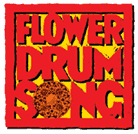 novel by C.Y. Lee, Flower Drum Song was adapted into a Broadway musical by the classic team of Rodgers and Hammerstein in the 1950s, and became an unexpected hit, running for over 800 performances on Broadway and undergoing a national tour. But while an unexpected hit, the show was never considered much more than a minor addition to the Rodgers and Hammerstein pantheon, which was established decades before by such legendary shows as Oklahoma and Carousel (and, ironically, Oklahoma is now being produced as a revival on Broadway). It has not been revived very often, either on Broadway nor in regional or community theatres across the country.
novel by C.Y. Lee, Flower Drum Song was adapted into a Broadway musical by the classic team of Rodgers and Hammerstein in the 1950s, and became an unexpected hit, running for over 800 performances on Broadway and undergoing a national tour. But while an unexpected hit, the show was never considered much more than a minor addition to the Rodgers and Hammerstein pantheon, which was established decades before by such legendary shows as Oklahoma and Carousel (and, ironically, Oklahoma is now being produced as a revival on Broadway). It has not been revived very often, either on Broadway nor in regional or community theatres across the country.
There are reasons for this. First, of course, is the demands of the show; it needs an entire cast of Asian American performers. Not that this stopped the original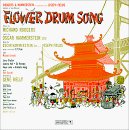 production, which saw the non-Asian Larry Blyden and Juanita Hall play major roles. Second, and perhaps more importantly, is that the adaption, unavoidably done by the non-Asian team of Fields, Rodgers and Hammerstein, took an unavoidably narrow view of the Chinese community. It was an outsider's view, focussing on the quaint and the exotic and focussing on the "touristy" side, which was entirely at odds with the much more bittersweet tone of Lee's novel. In the current climate, and with the more sophisticated tastes of both Asian and non-Asian audiences, such a book would unnecessarily grate on their tastes, given that this is the only example of Asian American culture in the entire library of the American musical theatre.
production, which saw the non-Asian Larry Blyden and Juanita Hall play major roles. Second, and perhaps more importantly, is that the adaption, unavoidably done by the non-Asian team of Fields, Rodgers and Hammerstein, took an unavoidably narrow view of the Chinese community. It was an outsider's view, focussing on the quaint and the exotic and focussing on the "touristy" side, which was entirely at odds with the much more bittersweet tone of Lee's novel. In the current climate, and with the more sophisticated tastes of both Asian and non-Asian audiences, such a book would unnecessarily grate on their tastes, given that this is the only example of Asian American culture in the entire library of the American musical theatre.
During the 60s and 70s, with the emergence of Asian American consciousness, both the play and novel came in for their share of derisive scorn from activist. Under the emerging demand for self determination and the urge to define our own images, the Asian American community rejected both the musical and novel as being overly influenced by a patronizing mainstream culture; both were seen as sanitized and emasculated verions of the "true" Chinese American community, which was shaped by poverty, immigration pressures and racism.
And yet.....and yet....Asian Americans are heir to both Asian and American culture, forming their own unique culture, influenced by both but are not equivalent to either (as doctrinaire so succinctly put it). Part of that heritage from mainstream culture is the American musical, one of the two major American contributions to world culture. And Flower Drum Song was most definitely an expression of American culture...but with Asian Americans who sang, danced and fell in love. Despite all the problems we had with the show, despite the patronizing quaintness, despite all the gross distortions of Asian American history...there was those indeliable images of Asian American folks expressing themselves in such an American manner...
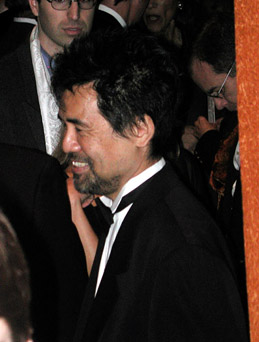 What to do? Enter David Henry Hwang. Having grown up with both the movie and with that ideology that shaped so much of his thought when he was in college in the 70s, he harbored, like so many Asian Americans, these rather ambivalent thoughts about the show. Unlike other Asian Americans, he had the moxie and the clout to do something about it, backed up by a shelf full of theatrical awards. He proposed to the Rodgers and Hammerstein people to revise the book (but not necessarily the score) to Flower Drum Song, taking it back closer to the original source material and refurbishing it so that it spoke anew to a 21st Century audience.
What to do? Enter David Henry Hwang. Having grown up with both the movie and with that ideology that shaped so much of his thought when he was in college in the 70s, he harbored, like so many Asian Americans, these rather ambivalent thoughts about the show. Unlike other Asian Americans, he had the moxie and the clout to do something about it, backed up by a shelf full of theatrical awards. He proposed to the Rodgers and Hammerstein people to revise the book (but not necessarily the score) to Flower Drum Song, taking it back closer to the original source material and refurbishing it so that it spoke anew to a 21st Century audience.
So that explains what the Revue was doing at the Virginia Theatre, hobnobbing with a mob of tuxedoed men and designer dressed women (including more than a few whose ideas of both taste and Chinese fashion left something to be desired), and rubbernecking to see how many names he could pick up for dropping into later conversations.
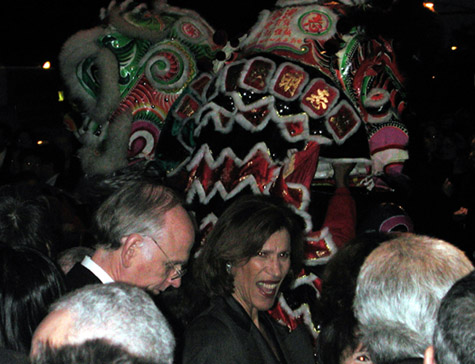
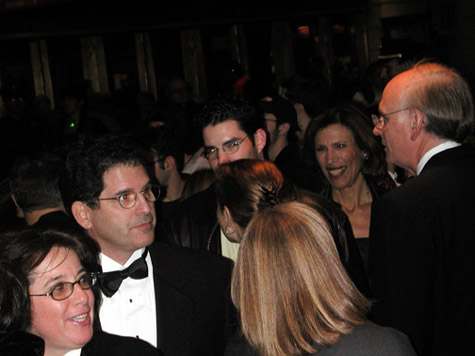
Home | News | Calendar | Directory | Library | Plays
Questions? Email gwangung@u.washington.edu